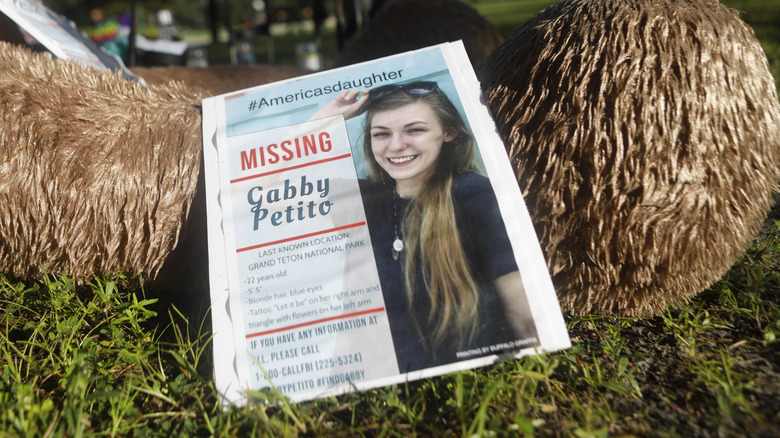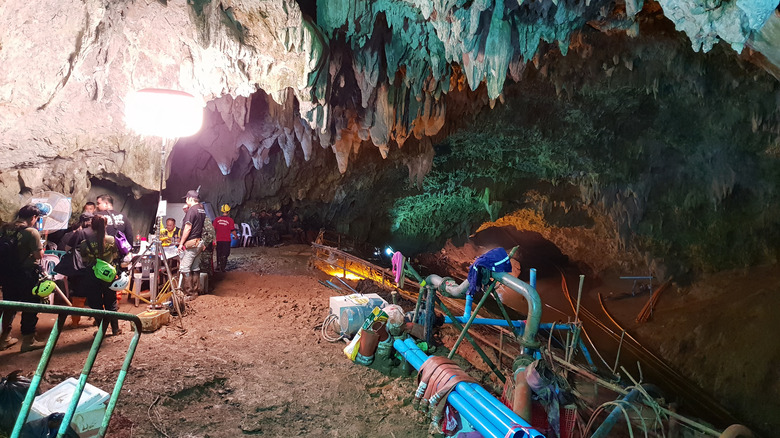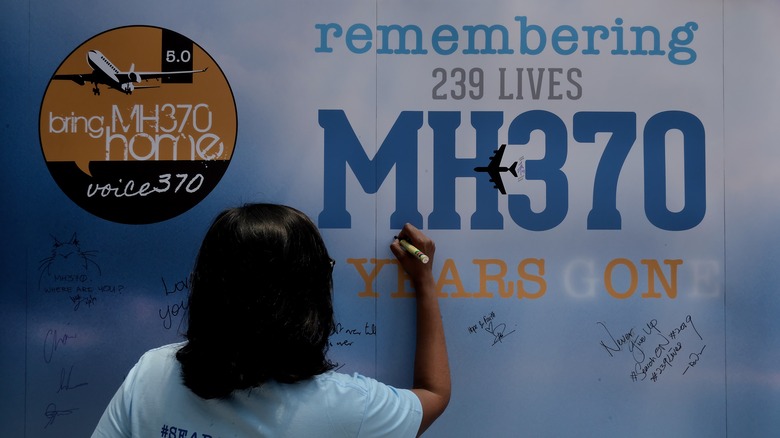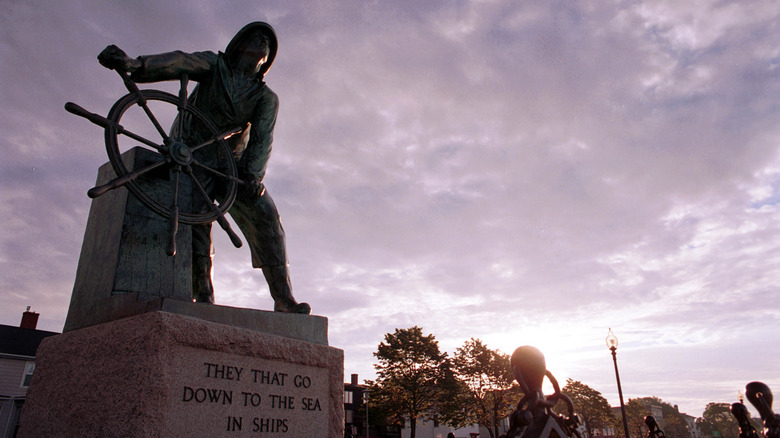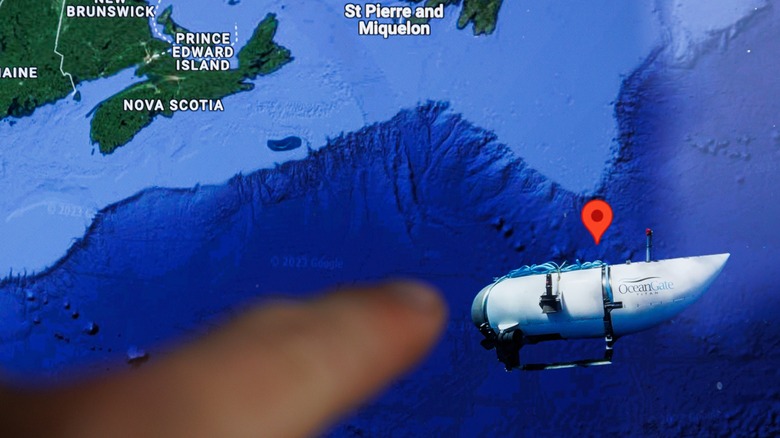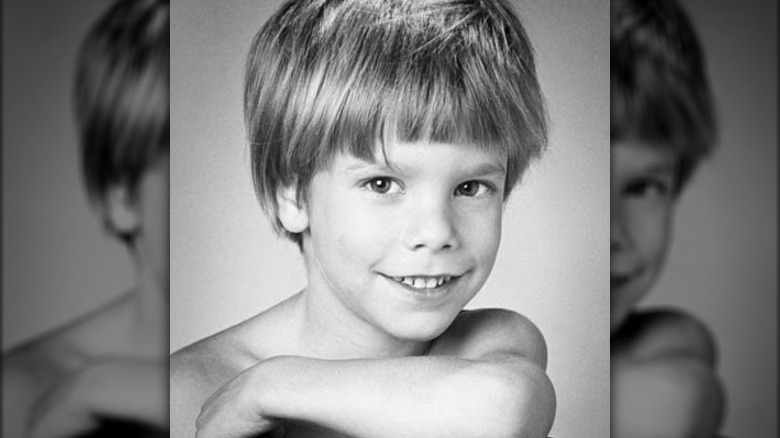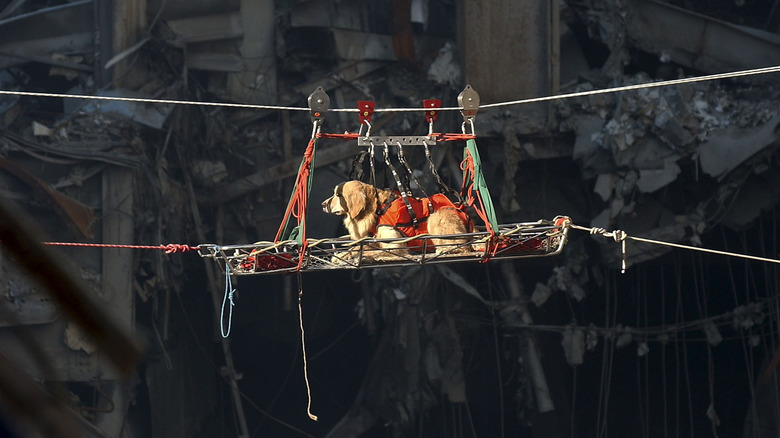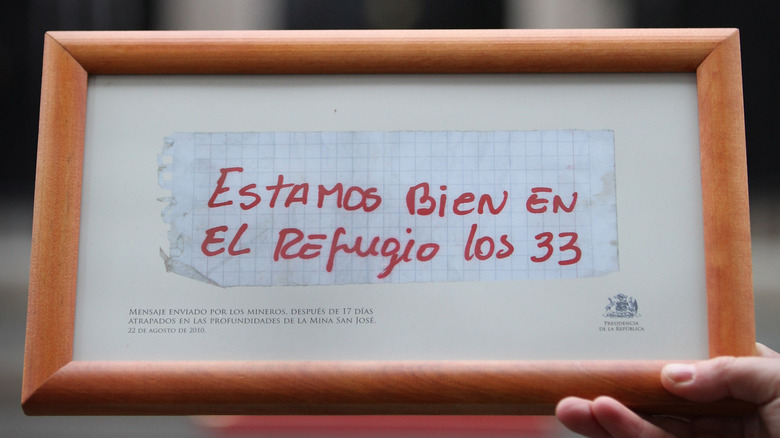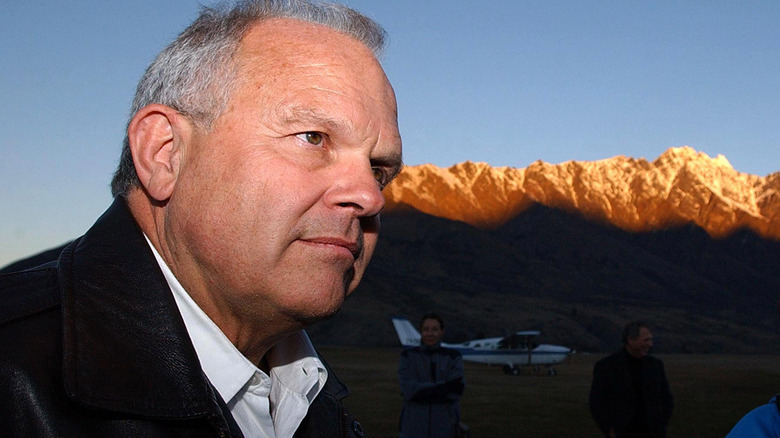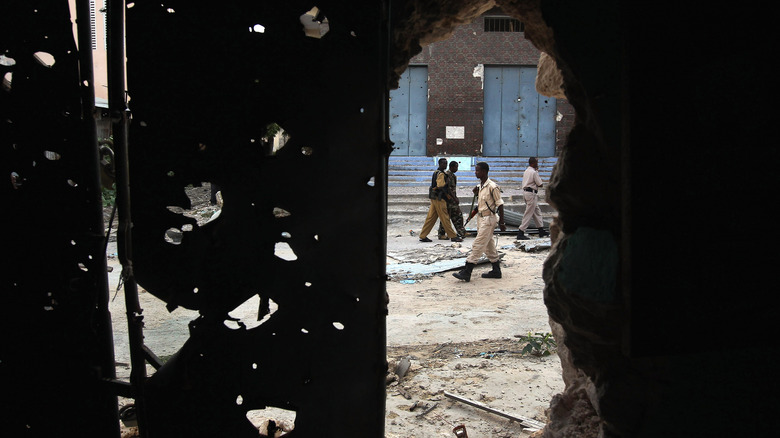The Biggest Search And Rescue Missions Of The Last 50 Years
Someone famous once said something about the world being an awful place (probably), and it's true. (Definitely.) Somewhere, someone is having the worst day of their life, and if that's not a disheartening thought, then nothing is.
Sometimes, that bad day is so bad it results in a search and rescue attempt. And while everyone loves a story of the good guys swooping in to save the day, it's worth mentioning here that the challenges faced by SAR teams are only growing. When Outside took a look at the state of SAR in 2020, they found organizations that were vastly underfunded, completely overwhelmed, and a social media-driven culture that was actually getting more and more people into trouble. (Who, after all, has to come to the rescue when those selfies take a turn for the worse?) And many of the people who are doing the rescuing are volunteers that are giving up their own time to help those in need.
So, with a shout-out to all the search and rescue personnel that are on call to drag people out of places they probably shouldn't have been in the first place, let's take a look at some of the biggest SAR operations of the past 50 years. These are the natural disasters, the terrorist attacks, the hostage situations, and the mysterious disappearances that captured the public's attention ... and didn't always end well.
The Tham Luang cave rescue
It was 2018, and the media latched onto the story of the disappearance of a young Thai football team with a fascination that meant recounting the search-and-rescue blow-by-blow, minute-by-minute. Could the media frenzy have been distracting, and even potentially dangerous? Absolutely. In 2021, British diver Rick Stanton told The Guardian that the added pressure could have been catastrophic: "We knew that everybody in the world was looking at it ... but we just had blinkers to that."
It started off innocently enough, when a soccer team made up of 12 boys from 11-16 years old and their assistant coach headed off after practice, bound for the nearby Tham Luang cave. They'd been there countless times before, but this time, flooding left them trapped almost 2.5 miles from the cave's entrance.
Divers spent days laying guide ropes, searching for unflooded caverns to use as bases, and a week after the 13 were trapped, they were discovered by two rescue divers. Then, rescue diver Ben Reymenants told the BBC: "Now, the real hard work comes in." With the tunnels too narrow in places to wear scuba gear and some of the boys unable to swim, rescue crews began the long, dangerous process of pulling them out one at a time. Although two rescuers died over the course of the two-week ordeal, all of the boys and their coach were rescued, leading to a social media post by the Thai Navy SEALs that read: "We are not sure if this is a miracle, science, or what."
The search for MH370
When Malaysia Airlines Flight MH370 disappeared on March 8, 2014, it's safe to say that the world was shocked. The eerily silent vanishing of the Boeing 777 made international headlines, and what unfolded was one of the largest search and rescue operations in history.
A week after the plane's disappearance, The Washington Post reported that the search had expanded from along the flight path to cover a massive area over southeast Asia and the Indian Ocean. (Why? A cabin decompression could have killed passengers but the plane may have kept going, similar to what happened in the 1999 plane crash that took the life of professional golfer Payne Stewart.) Hundreds of journalists hung on every word of the official updates, and by March 17, there was a lot of data to sift through, but no answers.
The search involved requests for radar data from a whopping 26 countries, and when it came to those who sent ships, planes, and experts to assist, 14 countries helped, including those in the area — like China, Vietnam, and Indonesia — and those from a good distance away, like the U.S., Kazakhstan, Uzbekistan, and Pakistan. In spite of the incredible turnout, it wasn't until 2015 that the first piece of debris — from the plane's right wing — was discovered a full 2,300 miles outside of the main search area. The search wasn't called off until 2017, and mysteries surrounding the disappearance remained unsolved.
Jessica Lynch
Generally speaking, the war in Iraq was a mess. On the front lines, though, was a young Army recruit named Jessica Lynch, and when her caravan was ambushed on March 23, 2003, the search and rescue operation that unfolded was massive. Seven days after her capture, U.S. Special Forces stormed a hospital, rescuing Lynch and recovering the bodies of others from her unit. At the time of the rescue, The Guardian reported Lynch had been escorted from the hospital and evacuated on a Black Hawk helicopter, after a joint, nighttime operation run by Army Rangers and the Navy SEALs.
As the story unfolded, it became clear that Lynch was the poster child for the war: She was described as the "Rambo from West Virginia," and the media frenzy went all the way to the front door of her parents' home. In a piece for Glamour, Lynch wrote of her shock at learning about the stories that had fueled not only fervor for her rescue but a fierce, nationwide sense of pride and patriotism ... only, she wrote, it didn't happen the way that everyone else said it happened.
Since then, Lynch has been outspoken in setting the record straight: She didn't fire her gun, she didn't go down in a hail of gunfire, and she doesn't even remember most of her captivity. She wrote: "Occasionally, I have nightmares about people chasing me and wanting to kill me. But still, I'm lucky. I got to come home, when so many others didn't."
The Andrea Gail
Technically, the 1991 storm that sank the fishing vessel Andrea Gail didn't even have a name. That said, it was popularly called "The Perfect Storm," and was immortalized by first a book, then a movie. The story, however, was heartbreakingly true.
The last communication the Andrea Gail had with anyone was a call to another fishing boat captain, Linda Greenlaw. She later recalled the conversation being fairly normal, with the weather only starting to kick up. "I wanted a weather report, and Billy [captain of the Andrea Gail] wanted a fishing report. I recall him saying, 'The weather sucks. You probably won't be fishing tomorrow night,'" she said (via Boston). And then? Nothing.
The U.S. Coast Guard aircraft covered thousands of square miles — as much as 21,000 a day — along and around the area the ship was last reported as being in, and along the path back to the coast. The search, however, was made more difficult by the lack of communication from the ship and the fact that there was no signal from emergency beacons or life rafts, leaving would-be rescuers to fear the worst (via the Gloucester Times). The search lasted for 10 days, and Maryanne Shatford, sister of crewman Bob Shatford explained the heartbreak: "You know in your heart ... how could anyone survive that storm? But all you have is hope. You sit around together, and you wait for news, and you hope."
OceanGate Expedition's Titan submersible
In June of 2023, the world learned about an ultra-elite tour company called OceanGate, which was offering 8-day trips that included an outing to see the final resting place of the Titanic. For a cool $250,000 per person, visitors would get a deep-sea dive in the submersible Titan ... which, if it sounds dangerous, that's because it's ultimately what it proved to be.
The sub went missing on June 18, with five people on board. Limited air on board put a timer on the rescue mission, which turned into a massive, international effort that was, in part, spurred by reports that semi-regular banging noises were detected in the area the sub went missing (via The New York Times). And it was the whole world that watched, even as the media re-published quotes like this one, from OceanGate founder (and Titan passenger) Stockton Rush (via CNN): "At some point, safety is just pure waste. I mean, if you want to be safe, don't get out of bed. Don't get in your car. Don't do anything."
In addition to military ships and vehicles from multiple nations, others joined in the search, too, including the Deep Energy, which was outfitted for laying deep-sea pipes, and a French research vessel called the L'Atalante. Unfortunately, it was ultimately announced that earlier sounds detected were of a "catastrophic implosion," and there were no survivors.
Etan Patz
It's no secret that times were different back in 1979, so when 6-year-old Etan Patz told his mother that he could walk the two blocks to the bus stop by himself — while she took care of the younger children at her home-based daycare — she let him. She never saw him again.
Photos of the little boy with the big smile were plastered all over New York City, and Patz became the first to be featured on milk cartons. According to The New York Times, the search was massive: Law enforcement searched the city apartment by apartment, room by room, while the rest of the nation watched, waited, and changed how they dealt with missing children. Even though the occasional imposter came forward claiming to be the adult Patz and the search and rescue mentality turned into simply a search for answers, authorities never stopped looking. Following tips, they held searches and even excavations of property in 2000 and 2012, and while those yielded no immediate results, the latter kind of did eventually.
When Patz's disappearance made it into the media again, a New Jersey man came forward with a suspect: his brother-in-law, Pedro Hernandez. He had confessed repeatedly to kidnapping and choking a boy, but with a lack of details, nothing ever came of it. Until — 33 years after Patz disappeared — Hernandez was arrested before being tried, re-tried, and finally found guilty in 2017. He was given 25 to life.
[Image by Stanleykpatz via Wikimedia Commons | Cropped and scaled | CC BY 3.0]
9/11
It's no secret that the events of 9/11 changed the landscape of America forever, and for the rescue workers who worked tirelessly in the aftermath of the terrorist attack, their lives were forever and irrevocably changed as well. For the 20th anniversary of the attacks, senior noncommissioned officer Fred Brown shared his memories of the search and rescue operation via the U.S. Army, and it was terrible, personal stuff: His mother-in-law worked in the Pentagon, but he hadn't been sure where. Eventually, he learned that one of the offices hit by the plane was hers, and when his team recovered her remains, she was only identified by her personal belongings.
The hardest realization, Brown shared, was the moment when they realized they were no longer search and rescue, but instead, were search and recovery. Search and rescue workers combing the remains of the Twin Towers came to a similar realization. Chris Selfridge and his dog, a golden retriever named Riley, were instrumental in recovering the remains of several firefighters. Years later, he told The New York Times, "We went there expecting to find hundreds of people trapped. But we didn't find anybody alive."
Still, search and rescue teams worked for stretches of 12 hours at a time, with the dogs becoming the face of continued efforts. Search, rescue, and recovery work went on for 9 months, and a memorial ceremony is held annually to mark the end of official efforts.
Gabby Petito
The connectivity of social media allowed the nation to keep track of the search for missing blogger Gabby Petito minute-by-minute, from the time she was reported missing on September 11, 2021, to the January 2022 announcement of the case's official and imminent closure. Over the course of the investigation, amateur armchair detectives sifted through all the information that could be found online, while a real-world search and rescue operation unfolded over tens of thousands of acres of the American West. After the recovery of her remains, her father issued a formal statement thanking law enforcement, search and rescue workers, and The AWARE Foundation. They estimated that their information on Petito had been viewed around 2 million times.
The search and rescue efforts for Petito had something of an odd consequence: They led to the discovery of other remains and the closure of other cases. Robert Lowery went missing the month before Petito, and also disappeared from the Bridger-Teton National Forest. Tips from the public led Teton County Search and Rescue to his remains, and officials said that without the high-profile Petito case, Lowery likely wouldn't have been found.
Search and rescue efforts prompted criticism, too, with some alleging that the disappearances of men, women, and children who were minorities were given less attention. That, says NBC News, led to an increase in interest in cases like the disappearance of Lauren Cho. Remains found near Yucca Valley, California, were discovered in October, and later identified as Cho.
Chilean miners' rescue
By the numbers, it's pretty staggering stuff: 33 miners, trapped for 69 days, after the collapse of a 770,000-ton stone cut them off from the above-ground world. And a rescue that was watched by somewhere around 1 billion people. There were 17 full, terrifying days when no one knew the fate of the trapped men, and it was only when rescue drillers pulled up their equipment to find a note tied to it that they knew they'd not only found the miners, but they were alive. The note read, "Estamos bien en El Refugio. Los 33." (We are good in The Refuge. The 33.)
Once the miners were found, there was a whole other set of issues to overcome. They were ultimately brought up through half a mile of stone in an incredible, 22.5-hour operation that saw, one by one, the men plucked from oblivion. All were noticeably grateful — one, Mario Sepulveda, had brought rocks up for some of the rescuers, which he handed out when he surfaced.
According to NPR's coverage, the rescue was in large part spearheaded by Chile's mining industry. As if the clockwork rescue wasn't awe-inspiring enough, more shocking was the fact that many of them were actually healthier than they had been before the collapse — they'd spent much of their time exercising. It was Sepulveda who perhaps summed it up the best, saying, "I think I had extraordinary luck. I was with God and the devil, and I reached out for God."
Steve Fossett
Anyone wanting their official job title to be "adventurer" has some pretty big shoes to fill, particularly when it comes to Steve Fossett. Fossett made his money as a commodities broker, and did some big things with it: For starters, he became the first person to fly around the world in a balloon — by himself. That was in 2002; five years later, in September 2007, he vanished over the American West.
The search and rescue effort was massive and included not only people out scouring the deserts, scrubland, and mountains over his flight path but also involved around 20,000 people using Google Maps to search from their own keyboards. At one point, the Smithsonian's Michael Behar went looking with a pilot on with the Civil Air Patrol: They left the Reno-Tahoe International Airport and headed out, just as searchers had been doing for the previous 24 days over five different states. They'd also been joined by the Air National Guard, a fleet of aircraft owned and volunteered by Barron Hilton, and scuba divers dredging the bottom of lakes. Together, they scoured tens of thousands of square miles.
By early October 2007, a month after he went missing, the official search was called off. It was almost a year to the day after that, in October 2008, that the wreckage of his plane was discovered, along with bones that were matched to Fossett through DNA testing.
Black Hawk Down
Phil Lepre was part of the rescue mission sent in to evac the soldiers initially shot down during the Battle of Mogadishu, which has — largely thanks to the book and the film — become more popularly known as Black Hawk Down. He told NPR what it was like going in: "I said a little prayer, took off my helmet, looked at my daughter's picture. I said, 'Babe, I hope you have a wonderful life.'"
A 1993 mission to arrest two high-ranking officers in the regime of Mohammed Aidid went bad almost out of the gate, and when two Black Hawk helicopters were shot down, the mission to arrest two men — which was expected to take about half an hour — turned into search and rescue mission involving some of the military's best: Delta Force and the U.S. Rangers.
That mission escalated into a 15 to 18-hour ordeal that ended with the killing of 18 American soldiers — including those who were dragged through the streets in the aftermath — and hundreds of Somalis. The pilot of one of the Black Hawk helicopters that was shot down was ultimately released 11 days later, thousands were injured, several hundred civilians were dead, and the U.S. pulled out of Somalia completely. The ripple effect of the botched arrest and bloody rescue attempt was far-reaching — not only has Somalia remained one of the most dangerous countries in the world, but the U.S. adopted a foreign policy that has made it reluctant to get involved in other overseas conflicts.
Captain Phillips and the Maersk Alabama
There are plenty of ways to measure how far you've gotten in life, and surely, one of those things is the answer to the question, "Has my life been immortalized in a Tom Hanks movie?" That answer is famously, "Yes!" for Captain Rich Phillips, but there's been considerable debate around the events of the hijacking of the ship the Maersk Alabama. What isn't argued is that after leaving port in Oman on April 1, 2009, he headed for Kenya via the waters of Somalia. A week later, the ship was chased and then boarded by Somali pirates. From there, it's a little hazy.
The U.S. military was alerted as soon as the hijacking occurred, even as the Somali pirates were making their demands, Navy planes and ships were routed in the right direction. Hours dragged on and on, while the military bandied about every possible solution. Ultimately, though, it was the USS Bainbridge and a crew of Navy SEALs that made the daring rescue. Phillips shared with NBC the moment that he saw the lights of the Bainbridge: "It was good to see. I mean, it allayed my thought that, 'I'm out here, nobody knows I'm out here. I'm all alone. I'm in a little bit of trouble.' ... The cavalry basically came in."
And came in, they did: Sharpshooters executed three of the pirates, while a fourth was arrested, tried, convicted, and sentenced to 33 years in jail. Phillips was lauded as a hero, along with the SEALs who rescued him.
